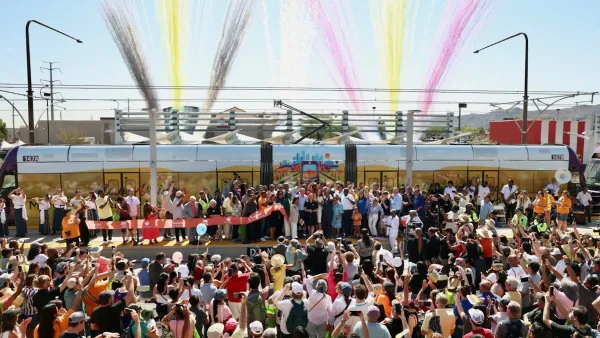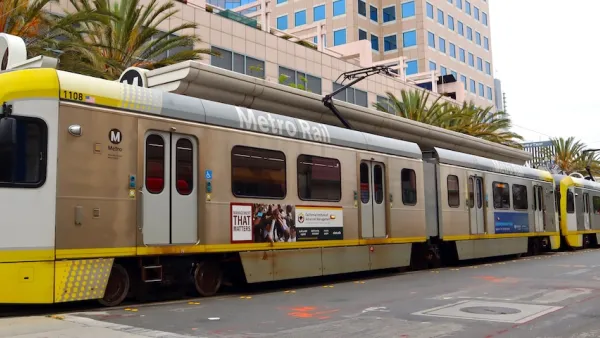Governing Magazine takes a look at the light rail explosion in the Southwest, particularly in Phoenix, where weather is a major factor in ridership.
"Hey! What do you know? It's cold!"
Rick Simonetta isn't talking about the temperature in downtown Phoenix, which today is 92 degrees in the shade. What's cold is the water he's sipping from a fountain on the platform of an outdoor train station. Right now, the platform is eerily devoid of passengers, its modern, sage-colored ironwork glinting in the Southwestern sun. But come December, when Phoenix opens its first light-rail line, this station will anchor a huge regional transit system that will stretch north to Glendale and east to Mesa and Tempe. It's a $1.4 billion, 20-mile catapult into transit - no other light-rail system in the country has been so large right from its inception.
As Simonetta, the system's CEO, inspects the gleaming new stations, he's focused on the details. Phoenix, he notes excitedly, will boast - make that boasts already - the first light-rail stations anywhere with chilled water fountains. Simonetta figures that will be a necessity if he's going to persuade drivers to get out of their air-conditioned cars and stand in the heat waiting for trains. To that end, other touches at the stations include sweeping sail-shaped sun shades, tilted in a way that keeps at least 40 percent of the platform shaded at all times, and sand-colored concrete that deflects heat rather than absorbs it. Simonetta can easily envision this station teeming with commuters headed to work, college students on their way to class and other residents coming downtown to shop, catch a concert or watch basketball's Suns or baseball's Diamondbacks play."
FULL STORY: Leaping into Light Rail

Planetizen Federal Action Tracker
A weekly monitor of how Trump’s orders and actions are impacting planners and planning in America.

Maui's Vacation Rental Debate Turns Ugly
Verbal attacks, misinformation campaigns and fistfights plague a high-stakes debate to convert thousands of vacation rentals into long-term housing.

Restaurant Patios Were a Pandemic Win — Why Were They so Hard to Keep?
Social distancing requirements and changes in travel patterns prompted cities to pilot new uses for street and sidewalk space. Then it got complicated.

In California Battle of Housing vs. Environment, Housing Just Won
A new state law significantly limits the power of CEQA, an environmental review law that served as a powerful tool for blocking new development.

Boulder Eliminates Parking Minimums Citywide
Officials estimate the cost of building a single underground parking space at up to $100,000.

Orange County, Florida Adopts Largest US “Sprawl Repair” Code
The ‘Orange Code’ seeks to rectify decades of sprawl-inducing, car-oriented development.
Urban Design for Planners 1: Software Tools
This six-course series explores essential urban design concepts using open source software and equips planners with the tools they need to participate fully in the urban design process.
Planning for Universal Design
Learn the tools for implementing Universal Design in planning regulations.
Heyer Gruel & Associates PA
JM Goldson LLC
Custer County Colorado
City of Camden Redevelopment Agency
City of Astoria
Transportation Research & Education Center (TREC) at Portland State University
Jefferson Parish Government
Camden Redevelopment Agency
City of Claremont





























